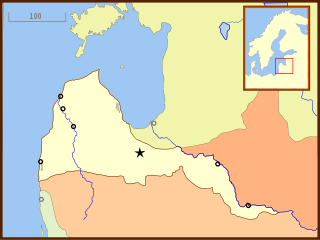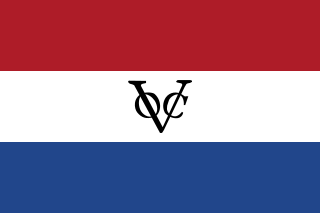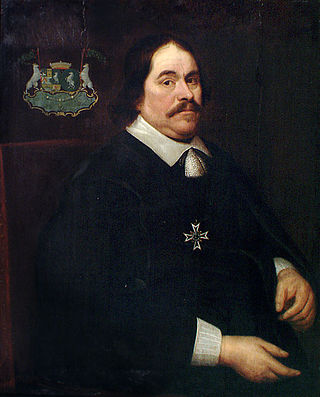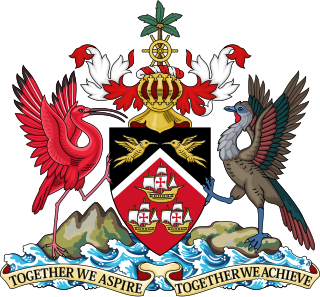Related Research Articles
The history of Trinidad and Tobago begins with the settlements of the islands by Indigenous First Peoples. Trinidad was visited by Christopher Columbus on his third voyage in 1498,, and claimed in the name of Spain. Trinidad was administered by Spanish hands until 1797, but it was largely settled by French colonists. Tobago changed hands between the British, French, Dutch, and Courlanders, but eventually ended up in British hands following the second Treaty of Paris (1814). In 1889, the two islands were incorporated into a single political entity. Trinidad and Tobago obtained its independence from the British Empire in 1962 and became a republic in 1976.

The Netherlands began its colonization of the Americas with the establishment of trading posts and plantations, which preceded the much wider known colonization activities of the Dutch in Asia. While the first Dutch fort in Asia was built in 1600 in present-day Indonesia, the first forts and settlements along the Essequibo River in Guyana date from the 1590s. Actual colonization, with the Dutch settling in the new lands, was not as common as by other European nations.

German attempts at the colonization of the Americas consisted of German Venezuela, St. Thomas and Crab Island in the 16th and 17th centuries.

The Duchy of Courland and Semigallia was a duchy in the Baltic region, then known as Livonia, that existed from 1561 to 1569 as a nominally vassal state of the Grand Duchy of Lithuania and subsequently made part of the Crown of the Polish Kingdom from 1569 to 1726 and incorporated into the Polish–Lithuanian Commonwealth in 1726. On March 28, 1795, it was annexed by the Russian Empire in the Third Partition of Poland.

The Curonian colonization of the Americas was performed by the Duchy of Courland and Semigallia, which was the second-smallest state to colonise the Americas, after the Knights of Malta. It had a colony on the island of Tobago from 1654 to 1659 and intermittently from 1660 to 1689.

The Honourable George Percy was an English explorer, author, and early Colonial Governor of Virginia.
Francis Willoughby, 5th Baron Willoughby of Parham was an English peer of the House of Lords.

Curonian colonisation refers to the colonisation efforts of the Duchy of Courland and Semigallia, a vassal duchy of the Polish–Lithuanian Commonwealth. Small, but wealthy, the Duchy took a modest part in the European colonization settlement attempts of West Africa and the Caribbean.

Jacob Kettler was Duke of Courland and Semigallia from 1642 to 1682. Under his rule, Courland and Semigallia became more independent of its Polish suzerain, reached its peak in wealth, and even engaged in its own overseas colonization, making it one of the smallest, but fastest growing states in the world at that time.

The Bishopric of Courland was the second smallest (4500 km2) ecclesiastical state in the Livonian Confederation founded in the aftermath of the Livonian Crusade. During the Livonian War in 1559 the bishopric became a possession of Denmark, and in 1585 sold by Denmark to Poland–Lithuania.

Crown Point is a town in southwestern Tobago, Trinidad and Tobago. It contains the A.N.R. Robinson International Airport which was formerly known as the Crown Point International Airport. It is near Store Bay, Buccoo Reef, and Pigeon Point. Crusoe Cave is located nearby.

Abraham Crijnssen was a Dutch naval commander, notable for capturing the English colony in Suriname in 1667 during the Second Anglo-Dutch War, resulting in the establishment of a long-term colony under Dutch control. The minesweeper HNLMS Abraham Crijnssen and the frigate HNLMS Abraham Crijnssen have been named after him.

Mauritius was an official settlement of the Dutch East India Company on the island of Mauritius between 1638 and 1710, and used as a refreshing station for passing ships. It was already frequented by Dutch ships from 1598 onwards, but only settled in 1638, to prevent the French and the British from settling on the island.
Cornelius Caroon was the Governor of New Courland, on Tobago from 1643 to 1650.

Adrian Lampsins, sometimes called Adrien Lampsius, (1598-1673) was the Baron of colonial Tobago, alongside his brother, Cornelius Lampsins.

Cornelius Lampsins, was, along with his brother Adrian, the Baron of Tobago from 1662 to 1664.

The Lampsins were an aristocratic family in the Netherlands, who attained notability in the trading and colonial worlds in the 17th century. The most notable members of the family were brothers Adrian and Cornelius Lampsins, who were granted letters of patent by Louis XIV and became the Barons of colonial Tobago in 1662.
Robert le Frichot des Friches, sieur de Clodoré was a French governor of Martinique from 1665 to 1667. He was an energetic and effective leader during the Second Anglo-Dutch War, in which France was an ally of the Dutch from the start of 1666. He used Caribs as auxiliaries, and helped take several islands in the Antilles from the English.

The history of Tobago covers a period from the earliest human settlements on the island of Tobago in the Archaic period, through its current status as a part of the Republic of Trinidad and Tobago. Originally settled by indigenous people, the island was subject to Spanish slave raids in the sixteenth and early seventeenth century and colonisation attempts by the Dutch, British, French, and Courlanders beginning in 1628, though most colonies failed due to indigenous resistance. After 1763 Tobago was converted to a plantation economy by British settlers and enslaved Africans.

Trinidadian and Tobagonian nationality law is regulated by the Trinidad and Tobago Constitution Order of 1962, as amended; the 1976 Citizenship Act, and its revisions; and various British Nationality laws. These laws determine who is, or is eligible to be, a national of Trinidad and Tobago. Trinidadian and Tobagonian nationality is typically obtained either on the principle of jus soli, i.e. by birth in Trinidad and Tobago or under the rules of jus sanguinis, i.e. by birth abroad to parents with Trinidadian and Tobagonian nationality. It can be granted to persons with an affiliation to the country, or to a permanent resident who has lived in the country for a given period of time through naturalisation. There is not currently a program in Trinidad and Tobago for persons to acquire nationality through investment in the country. Nationality establishes one's international identity as a member of a sovereign nation. Though it is not synonymous with citizenship, for rights granted under domestic law for domestic purposes, the United Kingdom, and thus the commonwealth, have traditionally used the words interchangeably.
References
- ↑ Riddell (Author), Henri de Bourbon (comte de Chambord.), John. “The Patent of Baron to C Van Lampsins.” The Pedigree of the Duchess of Mantua, Montferrat and Ferrara, Oxford University, 1885, pp. 8–10.